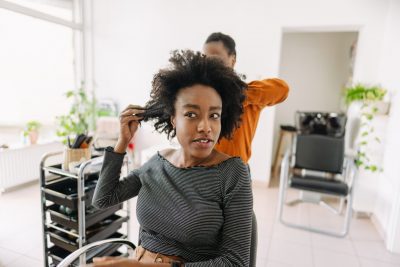Half of all women will experience hair thinning by the time they turn 50. African American women are particularly prone to certain forms of hair loss, and two-thirds of them will experience hair thinning by the age of 50. However, because not many doctors are familiar with black hairstyling practices, many women are left to sort through unhelpful and potentially harmful advice on their own.
African American women are particularly prone to certain forms of hair loss, and two-thirds of them will experience hair thinning by the age of 50. However, because not many doctors are familiar with black hairstyling practices, many women are left to sort through unhelpful and potentially harmful advice on their own.
So, what are the most common causes of hair loss in African American Women? And can anything be done to stop the thinning and regrow beautiful, healthy hair? Read on to find out.
What Causes Hair Loss in African American Women?
Two of the most common hair loss conditions that affect African American women are traction alopecia and central centrifugal cicatricial alopecia (CCCA). Other factors include genetics, age, postpartum hair loss, excessive stress, inadequate diet, illness, and certain medications.
- Traction Alopecia is caused by hair that is frequently pulled too tight, which causes inflammation in the hair follicle. Heat and chemical styling, weaves, dreadlocks, extensions, cornrows, tight ponytails, and braids can all contribute to this type of hair loss. Traction alopecia can often be reversed if one stops the behaviors that cause it.
- CCCA may be related to genetics, fungal or bacterial infections, or autoimmune disease. It can permanently damage hair follicles, meaning they will not be able to grow new hair.
- African American hair is more dry and fragile. Its unique texture limits the amount of moisture the hair can hold. Additionally, African American women generally have a lower hair density, meaning fewer hair follicles. This can make areas with already sparse hair more noticeable.
What Steps Can I take to Slow or Prevent Hair Loss?
Unfortunately, certain types of hair loss are genetic, meaning very little can be done to prevent them. These include alopecia areata and female pattern hair loss. However, other types of hair loss like generalized hair shedding can be brought on by excess stress and a poor diet. Taking care of your mental health, eating a nutritious diet, and staying up to date on your physical health can help.
It can be hard to tell if you’re losing hair especially if it happens gradually. You may notice your ponytails or braids aren’t as thick as they once were or that more of your scalp is visible. Ask your stylist (preferably someone you’ve seen for quite some time) if they’ve noticed any changes.
To protect your hair from traction alopecia and prevent further damage follow these tips:
- Ask your stylist to create looser dreadlocks or braids.
- If you have braids, remove them after three months to give your hair a break.
- If you wear a weave or hair extensions, remove them after eight weeks.
- If you relax or dye your hair, make sure these treatments are applied by a professional. If you notice breakage or hair shedding, try to avoid chemical treatments.
- Minimize heat styling, including hair dryers, flat irons and curling irons. They wear out the hair and can lead to damage and hair loss.
At DiStefano Hair Restoration Center, we recognize that restoring hair is not a one-size-fits-all approach. We combine artistry, experience, and state-of-the-art technology to achieve natural looking results for people of all racial backgrounds and ethnic groups. Schedule your free consultation today.


